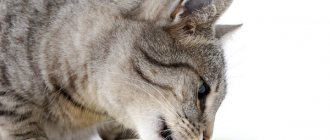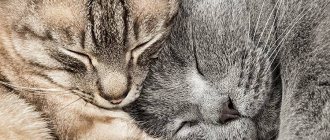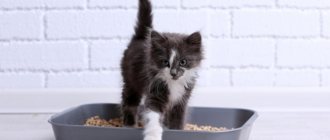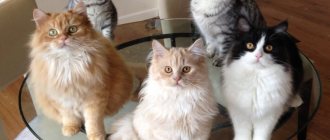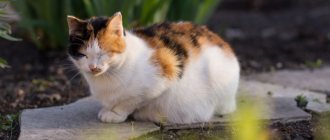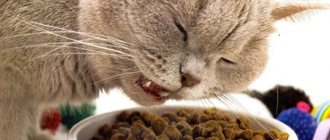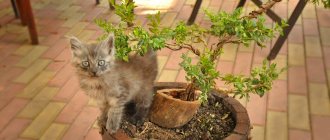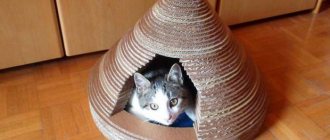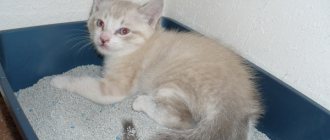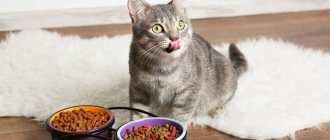Without mother's milk
Most often, little kittens feed on mother’s milk for quite a long time, especially if the cat herself allows it. However, after they are three weeks old, they begin to be interested in everything that is around, including the contents of the mother cat's plate. They cannot yet eat any food other than their mother’s milk, especially from a saucer, so it is in this situation that small kittens need human help. You need to learn how to teach a kitten to eat on its own .
Regular food
A small kitten is in many ways similar to a tiny human child, although some may consider such a comparison to be incorrect. Why is such an allegory given here? People teach their children to eat gradually, without haste, but the child still continues to eat mother’s milk or special formulas. You need to behave in exactly the same way with a small kitten. If there is no cat, and the kitten is very tiny, less than three weeks old, then you will have to feed it using a baby bottle or pipette.
Age-related features of cat nutrition
The cat feeds its children for two months, however, even despite this, in order for the transition to a normal diet to be successful, the kitten must be fed as soon as the first three weeks of its life have passed. At this time, babies can eat liquid porridge.
https://youtu.be/BZYnaEKrwQQ
When kittens are two months old, their first baby teeth grow in, and solid food can be gradually added to their diet at this time. So, by the age of ten weeks, the pet can eat all types of food, at which time it increasingly moves away from mother’s milk to the regular menu.
How to wean a cat off dry food and switch it to natural food
Let's consider popular ways to change the type of food for an animal:
- The transition to natural food must be gradual. Try mixing certain ingredients into dry food. At the beginning there should be a small amount of them. If the cat accepts your conditions, over time it is recommended to increase the proportion of natural food until you completely give up dry food. It is better to start with finely chopped pieces of boiled beef. It's healthy and tasty;
- If your pet has a preference for natural products, you should focus on them. It is recommended to gradually increase the portion of food of natural origin until you completely replace artificial food;
- If the owner does not know the preferences of the pet, you need to try the most common treats of other cats. They are laid out in front of the animal in various bowls . This way you let your pet know that he has a choice. This should be done until he decides. Then they act, as mentioned earlier, gradually increasing the portion of natural food;
- You can try giving your cat food in two different bowls . Moreover, one will be dry, and the other will be natural. You need to pour a smaller portion into the first container than into the second. The animal, without having eaten, will have to finish eating healthy food. There will be no other way out;
- The most radical and harsh way is to simply stop feeding the cat dry food . Every animal has an instinct of self-preservation, so it will have to agree to your terms. But these are extreme measures; it is better to try other, softer options.
When translating, you should try to use the least radical methods
Features of feeding a kitten during a change in diet
It is very important that complementary foods of any kind are introduced gradually. First, you should make ordinary liquid semolina porridge, using milk diluted with water; you should not put sugar in the porridge. After the baby's stool returns to normal, he can eat liquid rice, rolled oats and buckwheat porridges prepared with milk. At the same time, low-fat cottage cheese can be included in such feeding. It is necessary to take into account that the food that kittens eat will not be eaten completely, so there should be a small amount of food in the bowl.
In order to eat, kittens can come to the plate very often, but you need to make sure that no more than six times. When babies approach the age of two months, they need to learn to eat harder foods: boiled meat and fish, sometimes you can offer your pet fresh, but make sure that there are no large bones in it. Food should be cut into small pieces; sometimes you can add pieces of fish to porridge cooked in water. It is better to use ready-made store-bought canned food for young kittens, but carefully monitor your pet when he eats such food.
When can kittens eat themselves?
Why does a cat bite its owner’s legs: when you stroke it and for no reason
Self-feeding begins at one month. At this time, the cat or owner must teach the baby to feed.
Diet of a kitten aged 1-1.5 months
Animals aged 1 to 1.5 months must be fed liquid food 5-6 times a day. What to enter in the menu:
- vegetable or meat puree;
- liquid semolina porridge without sugar;
- skim cheese;
- boiled yolk.
It is important that dairy products do not contain any additives
Complementary feeding at 2 months of age
From the age of 2 months, the kitten's baby teeth erupt, so solid food is introduced. But liquid dishes cannot be removed, since they form the proper functioning of the digestive system.
At this age, the pet is fed:
- boiled lean meat;
- yolk;
- milk;
- cottage cheese;
- yogurt.
Important! Gradually the kitten grows, the need for food and nutrients increases. From an early age, you need to accustom your baby to fish, cereals and vegetables.
Nutrition for a 3 month old kitten
At this age, pets are actively growing, they are full of strength. Their teeth change, their skeleton intensively strengthens and develops, and their muscles grow. The total weight of food eaten per day should be about 200 g per 1 kg of weight. With normal size kittens, 400 g of food per day will be enough.
A baby at the age of 3 months needs to be fed 5-6 times a day. When he turns 4 months old, you can switch to 4 feedings a day. When choosing any diet, you cannot deviate from it.
Important! It is prohibited to combine the consumption of store-bought feed and homemade food.
The pet needs to be fed solid food rich in protein. Dairy nutrition needs to be varied. Experts recommend preparing vegetable dishes. Meat products should predominate; cereals make up less than half of the daily feeding.
Meat is necessary for the growing body because of its taurine content. The substance is important for the normal development of the eyes and heart. Natural nutrition does not mean that your pet needs to be fed from your table.
When kittens begin to eat themselves, it is recommended to include in the menu:
- boiled lean meat - chicken, beef, turkey;
- if there are no worms, you can give raw frozen meat, chopped into small pieces;
- fermented milk products without additives - yogurt, kefir;
- liquid cottage cheese;
- zucchini, pumpkin, cabbage in raw grated form. If the baby refuses, then you need to add the mixture to the porridge;
- boiled egg yolk;
- sea fish;
- porridge with milk. It is better to cook semolina and rice.
The kitten is also offered special greens grown on the windowsill, sprouted oat sprouts
How to accustom a kitten to a saucer
The most important question is considered here: when and how exactly to accustom a small pet to eating from a saucer and how long such a procedure will take. As mentioned above, a kitten begins to be interested in a bowl when it is approximately three weeks old, or rather, the baby is attracted to the food of its adult counterparts. For this reason, three weeks of age is the best and most suitable for accustoming a kitten to a bowl .
First, you need to pour a little milk into the saucer. Then wet your finger with milk and let the kitten lick it. When he realizes that it is tasty, place the baby near the bowl and carefully dip his face into the milk. At first he won't like it and will pull back, but then he will remember the taste of the milk that he just licked from the man's finger.
At first, the kitten will snort and sneeze incessantly, releasing funny bubbles from the milk. This is due to the fact that he is still mastering the technique of lapping, because not so long ago he did not have to do this - he simply sucked milk from the breast of his mother cat. In addition, sometimes you can notice that he climbs into the bowl with his feet, and such attempts need to be nipped in the bud.
To do this, simply remove it from the bowl, wipe its paws with a napkin and place the kitten next to the saucer. When he starts to climb into the bowl again, hold him back slightly. This way you can teach your pet that its paws should not be in the food.
A few necessary recommendations
- It happens that the baby refuses to eat from the bowl if, for example, it is too low. You can buy a bowl at a pet store that sits on a special stand.
- A pet starting to feed on its own should always have access to clean water.
- In order to find out whether the animal has enough food offered, you need to periodically inquire about the contents of the tray. If the kitten visits him regularly, then everything is fine and he has enough food to eat.
A little patience and understanding, and within a week the furball will learn to feed on its own. And it’s no longer so important at what age you teach your little pet to eat from a bowl; the main thing here is patience. There is no need to try to offer the tiny creature bread, potatoes or dry porridge, you just need to let him get used to food other than mother's milk.
4.5 / 5 ( 2 voices)
At what age do kittens start eating on their own?
Under natural conditions, breastfeeding in kittens continues for a long time. The number of feedings is noticeably reduced by 2-2.5 months, and in cases where the cat has a small litter, she can continue feeding for up to six months. However, in order for your little pet to easily and painlessly switch to independent feeding, complementary foods should be introduced from three weeks of age.
A kitten should be taught to feed itself from three weeks of age.
The first weeks of a kitten’s life are the most delicate, so you need to pay attention to the baby’s nutrition. To start complementary feeding, liquid porridge is suitable. And when the kittens reach two months and their baby teeth begin to appear, solid food can be introduced. With the right and patient approach, by the age of 10 weeks the pet will be able to completely switch to solid food.
Remember that the diet must be balanced and contain the necessary elements for harmonious development. It is important to decide from the very beginning what type of complementary feeding you will use and strictly adhere to it in the future: industrial or natural. Both options can provide your little friend with the necessary vitamins and minerals, so be guided by your capabilities. However, they cannot be mixed: the digestion of dry and natural food requires different enzymes and an acidic environment. Alternating food will inevitably lead to gastrointestinal problems for your cat.
Without mother's milk
A newborn kitten needs to be fed with special formulas.
If for some reason a kitten cannot eat mother's milk in the first weeks of life, the owner will have to take on the responsibilities of the mother cat.
Remember that cat milk has a certain composition and any substitutes must be suitable for a young and sensitive body. You can purchase dry formula for feeding at a veterinary pharmacy. But they are quite expensive, so you can do the preparation yourself. Here are some recipes:
- 0.5 liters of concentrated milk, egg yolk and 4 teaspoons of granulated sugar;
- 50 g whole cow's milk, 15 g whole milk powder, 2.5 g dry yeast;
- 50 ml of whole milk, 50 g of boiled milk, half a raw egg yolk, a teaspoon of corn oil;
- Dilute concentrated milk powder in fennel broth to the consistency of liquid gruel, adding a little cream;
- a glass of 6% milk, 1 raw egg, 1 teaspoon of honey (instead of milk, you can take 10% cream, dilute with boiled water 2 times).
Cow's milk is dangerous for kittens!
Important! Do not feed your baby whole cow's milk. It does not have sufficient nutritional value and may cause digestive upset.
Regular food
Not all food that is common in human terms is suitable for a cat. A cat's stomach is delicate and sensitive, so when choosing natural complementary foods, carefully consider the list of products in your pet's diet. The wrong choice of food will provoke allergic reactions, digestive problems and even serious diseases, such as urolithiasis or gastritis. The following products are clearly prohibited for your furry friend:
- cow's milk. As we have already written, it differs in composition from cat milk, so do not try to replace natural feeding with it. It may be dangerous;
- fermented milk products with high fat content;
- freshwater and raw fish. A contented cat with a fish in its mouth is nothing more than a myth. Freshwater and raw fish can serve as a source of worms and cause urolithiasis. It is up to the owner to decide whether to introduce sea fish into the diet or not. In general, it is not dangerous, but its introduction as complementary food is not necessary at first;
It is better to leave the fish to the owners
- sausage and sausage products. It’s hard to resist the temptation to share leftovers from the holiday table with your pet, but remember that due to the high fat content and content of salt and spices, such a product will be too heavy for the cat;
- Cats do not digest potatoes in any form, so we will also include them in the list of cat prohibited foods;
- legumes Peas, beans, soy and other legumes will cause painful bloating;
- cheese has a high fat content that a kitten’s stomach cannot handle;
- pork;
- chocolate. Chocolate is a common cause of cat poisoning encountered by veterinary clinics. Chocolate contains the poison methylxanthine, or theobromine, which can cause tremors, convulsions in a kitten, increase the frequency of heart muscle contractions and even lead to death. Interesting fact: despite the fact that dark chocolate is considered healthier than milk chocolate, it contains 10 times more substances that are toxic to cats;
- flour.
It's better to leave sweets for people
The list of food dangerous for kittens is impressive, but do not rush to panic and go for industrial food. Something in your refrigerator will probably be suitable for the diet of a small pet. For example, vegetable and semolina porridge, low-fat cottage cheese, boiled egg yolk. It is important to ensure that dishes do not contain spices or additives.
